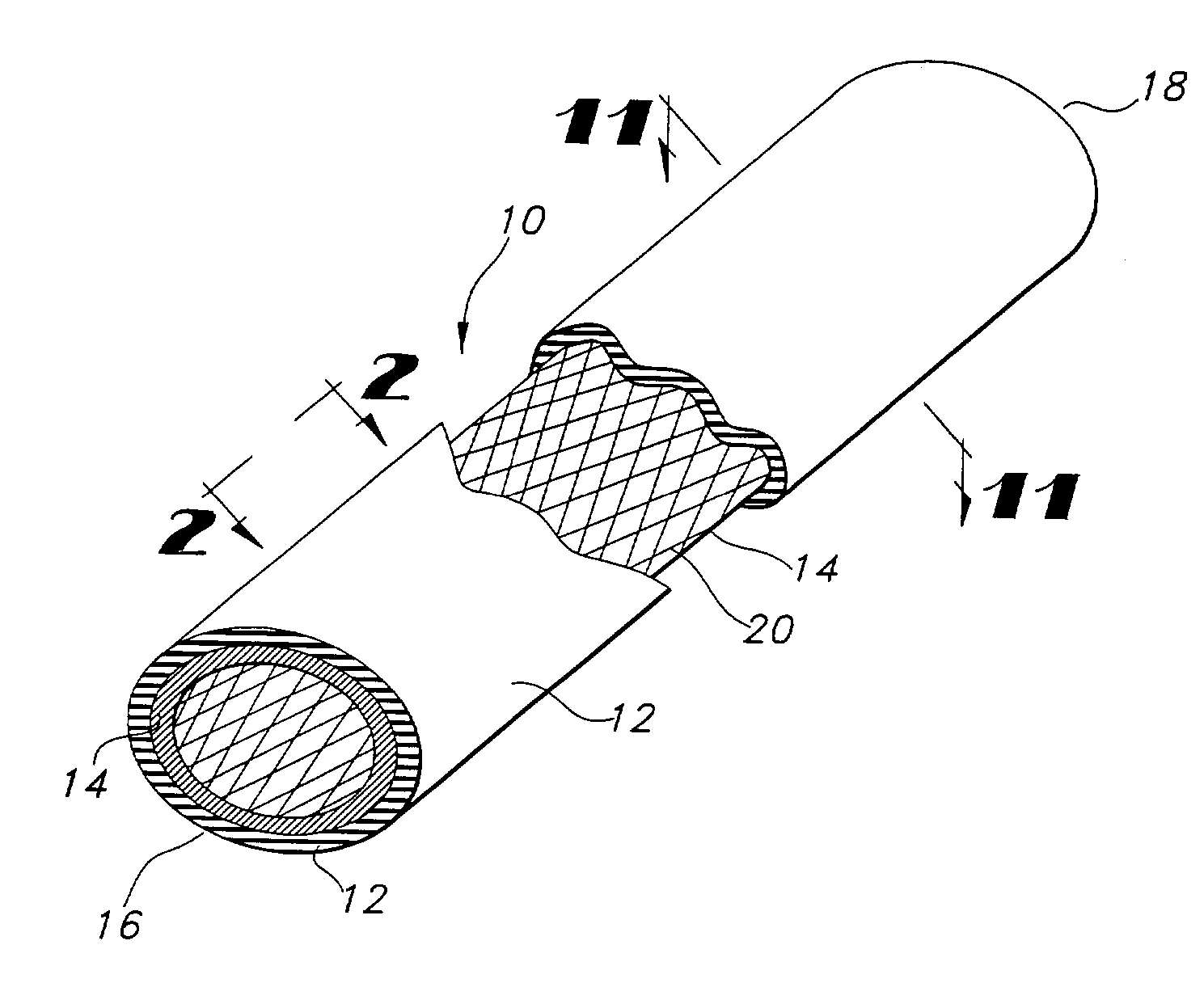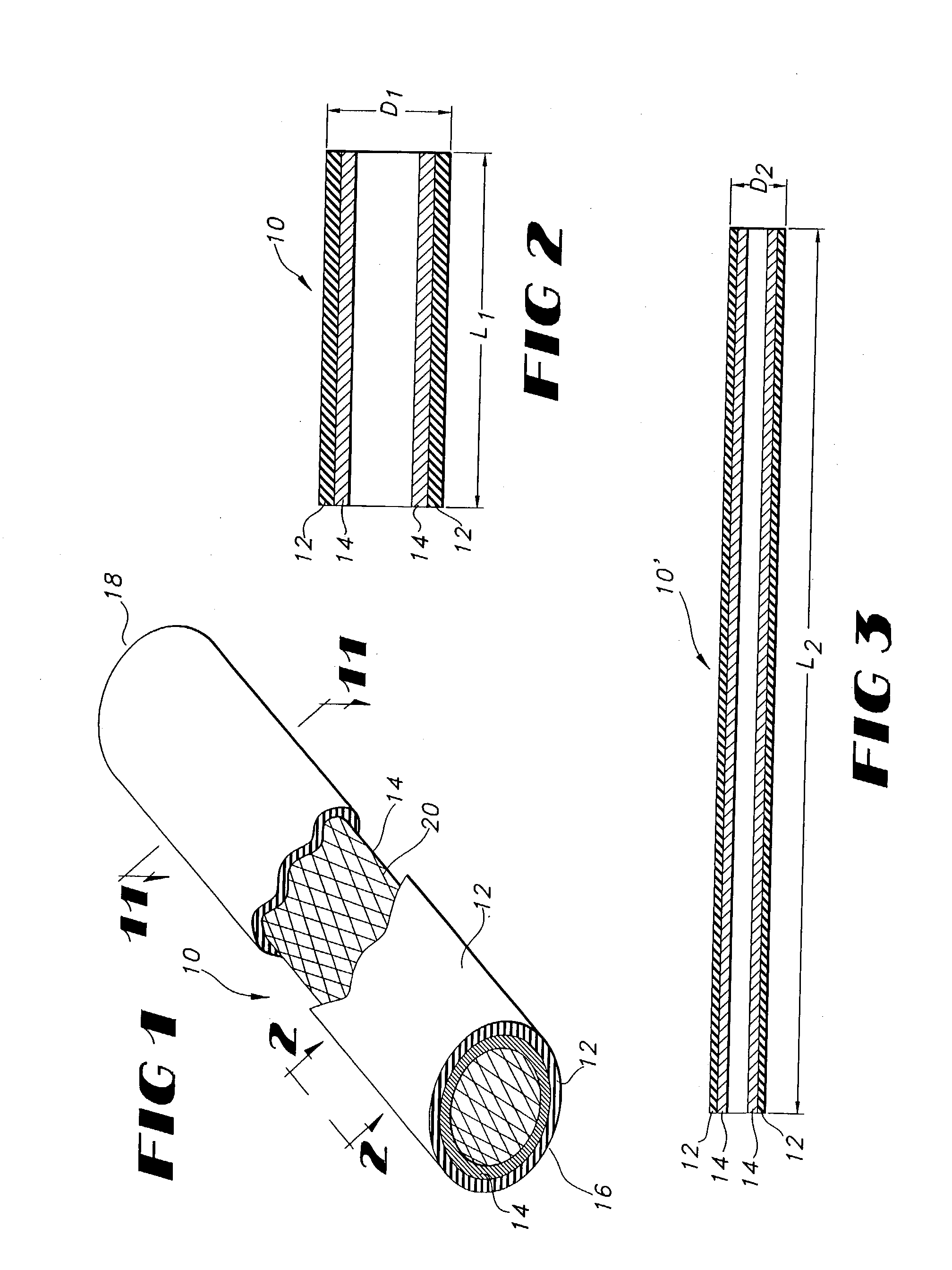Low profile, high stretch, low dilation knit prosthetic device
a prosthetic device and low-profile technology, applied in the field of intraluminal prosthesis, can solve the problems of dilatation of intraluminal devices, complicated implantation of stent-grafts, and complicated placement of stent-grafts on stents and stent-grafts,
- Summary
- Abstract
- Description
- Claims
- Application Information
AI Technical Summary
Benefits of technology
Problems solved by technology
Method used
Image
Examples
example 1
Single Layer Knit Tubular Graft With a Three Needle Underlap
[0078] The following specifications are used to fabricate a solid knitted prosthesis of the present invention.
[0079] Yarn Type: Texturized polyethylene terephthalate (PET), 40 denier, 27 filaments.
[0080] Machine Type: 56 Guage Kidde machine.
[0081] Number of Guide Bars: Eight
[0082] Guide Bar Threading Details: (y-Threaded / n-Not Threaded)
[0083] Guide Bar No. 8: y / y / y / y / y / y / y / y / n / n / n
[0084] Guide Bar No. 7: y / n / n / n / n / n / n / n / n / n / n
[0085] Guide Bar No. 6: n / n / n / n / n / n / n / n / n / n / y
[0086] Guide Bar No. 5: y / n / n / n / n / n / n / n / n / n / n
[0087] Guide Bar No. 4: n / n / n / n / n / n / n / n / n / y / n
[0088] Guide Bar No. 3: y / n / n / n / n / n / n / n / n / n / n
[0089] Guide Bar No. 2: y / n / n / n / n / n / n / n / n / n / n
[0090] Guide Bar No. 1: y / y / y / y / y / y / y / y / n / n / n
[0091] Guide Bar Position Details:
[0092] Guide Bar No. 1: 6-8-4-4 / 2-0-4-4 / (repeat) Front Full Thread
[0093] Guide Bar No. 8: 4-4-2-0 / 4-4-6-8 / (repeat) Back Full Thread
[0094] Guide Bar No. 2: 4-6-2-2 / 0-0-0-2 / (repeat) Right Connect
[0095] Guide...
example 2
Single Layer Stretch Knit Straight Tubular Graft with a Two-Needle Underlap
[0104] The following specifications were used to fabricate a super stretch knitted prosthesis of the present invention.
[0105] Yarn Type Used: Texturized polyethylene terephthalate (PET), 40 denier, 27 filaments.
[0106] Machine Used: 56 gauge Kiddie machine
[0107] Guide Bars Used: 6
3 Guide Bar Threading Details: (y - threaded, n - not threaded): Guide Bar n n y y y y y y y y y n No. 6 Guide Bar n y n n n n n n n n n n No. 5 Guide Bar n n n n n n n n n n n y No. 4 Guide Bar n n n n n n n n n n y n No. 3 Guide Bar y n n n n n n n n n n n No. 2 Guide Bar n n y y y y y y y y y n No. 1
[0108]
4 Guide Bar Chain Notation Details: Guide Bar No. 1: 2-0 / 4-4 / 4-6 / 2-2 / / repeat Front full thread Guide Bar No. 2: 4-2 / 4-4 / 2-2 / 2-0 / / repeat Left connector Guide Bar No. 3: 2-2 / 2-4 / 0-2 / 0-0 / / repeat Right connector Guide Bar No. 4: 0-0 / 0-2 / 2-4 / 2-2 / / repeat Right connector Guide Bar No. 5: 2-0 / 2-2 / 4-4 / 4-2 / / repeat Left connector Guide Bar N...
example 3
Single Layer Stretch Knit Bifurcated Tubular Graft with a Two Needle Underlap
[0113] The following specifications were used to fabricate a bifurcated super stretch knitted prosthesis of the present invention.
[0114] Yarn Type Used: Texturized polyethylene terephthalate (PET), 40 denier, 27 filaments.
[0115] Machine Used: 56 gauge Kiddie machine
[0116] Guide Bars Used: 10
5 Guide Bar Threading Details: (y - threaded, n - not threaded): Guide Bar n n y y y y n n y y y y n No. 10 Guide Bar n y n n n n n n n n n n n No. 9 Guide Bar n n n n n n n n n n n n y No. 8 Guide Bar n n n n n n y n n n n n n No. 7 Guide Bar n n n n n n n n y n n n n No. 6 Guide Bar n n n n n n n y n n n n n No. 5 Guide Bar n n n n n n n y n n n n n No. 4 Guide Bar n n n n n n n n n n n y n No. 3 Guide Bar y n n n n n n n n n n n n No. 2 Guide Bar n n y y y y n n y y y y n No. 1
[0117]
6 Guide Bar Chain Notation Details: Guide Bar No. 1: 2-0 / 4-4 / 4-6 / 2-2 / / repeat Front full thread Guide Bar No. 2: 4-2 / 4-4 / 2-2 / 2-0 / / repeat L...
PUM
| Property | Measurement | Unit |
|---|---|---|
| thickness | aaaaa | aaaaa |
| thickness | aaaaa | aaaaa |
| thickness | aaaaa | aaaaa |
Abstract
Description
Claims
Application Information
 Login to View More
Login to View More - R&D
- Intellectual Property
- Life Sciences
- Materials
- Tech Scout
- Unparalleled Data Quality
- Higher Quality Content
- 60% Fewer Hallucinations
Browse by: Latest US Patents, China's latest patents, Technical Efficacy Thesaurus, Application Domain, Technology Topic, Popular Technical Reports.
© 2025 PatSnap. All rights reserved.Legal|Privacy policy|Modern Slavery Act Transparency Statement|Sitemap|About US| Contact US: help@patsnap.com



